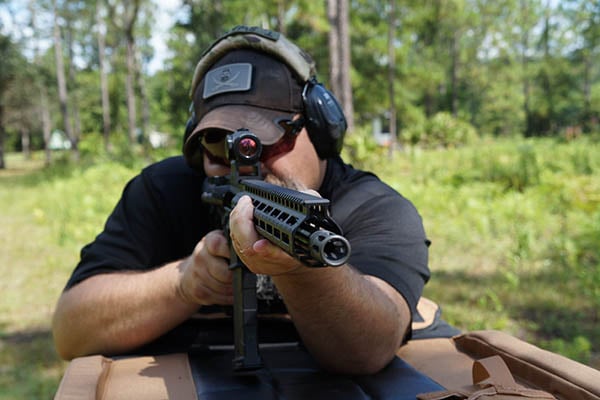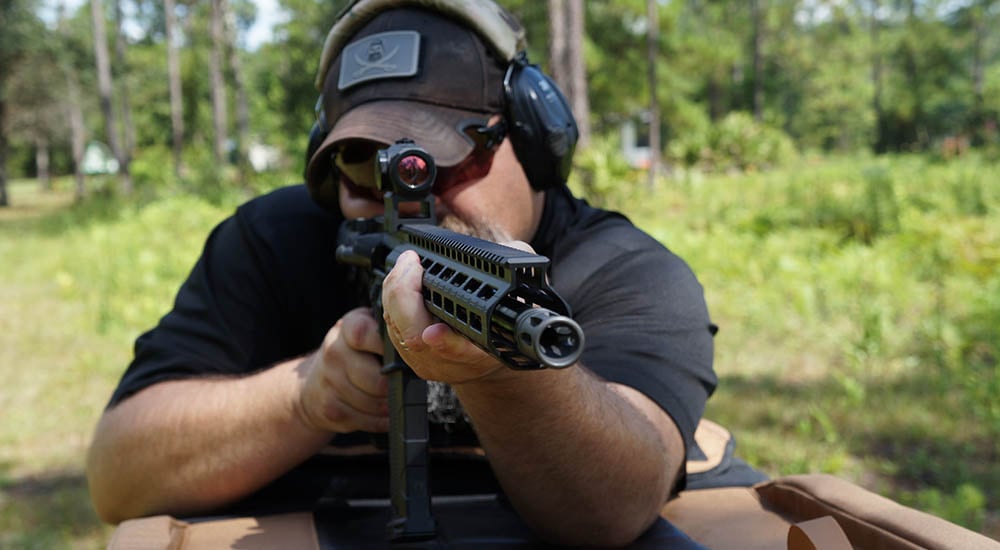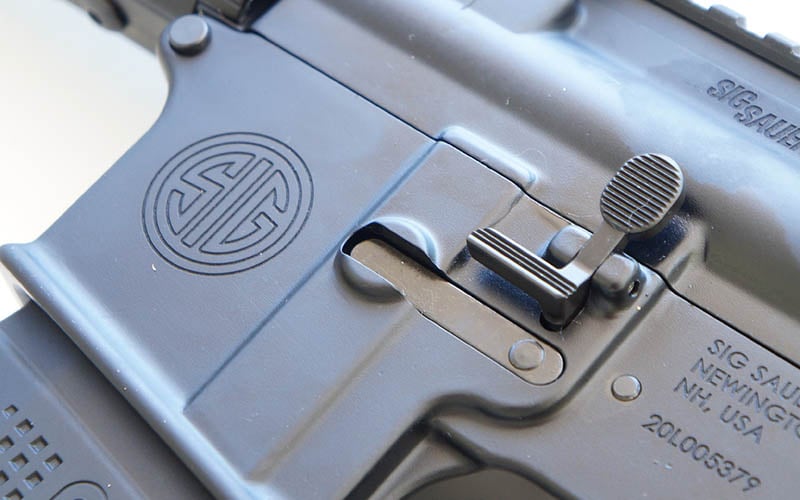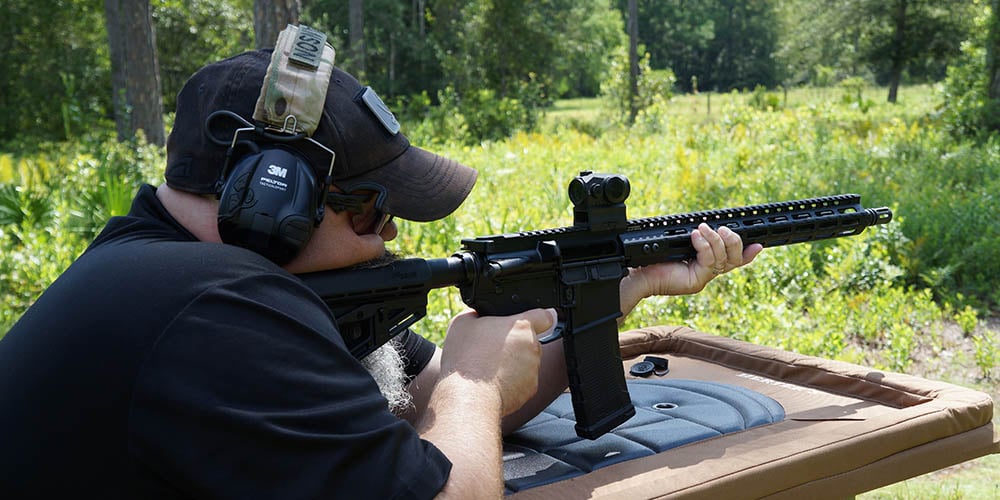
Last Updated on
Over the past decade, the hottest growing firearms platform in the industry has been by far the AR-15. With the recent “assault weapons ban” scare drummed up in the waning years of the Obama administration, production ramped up double time to keep up with panic buying. This only resulted in hurting the industry overall with price gouging, poor quality rifles and huge drop in values after the scare was over. With the new Trump administration enjoying success within its first year, the firearms industry has seen a drop in growing interest due to residing fears of losing their firearms rights and less panic buying. AR-15 platform rifles are showing up on the secondary market at 1/3 the cost of what buyers paid for them and interest have started to move to other platforms such as AK-47s and handguns. Luckily, there are a few companies that have continued to make high quality AR-15 rifles, such as SIG Sauer, to provide shooters with reliable, accurate and well-built products.

This week, we take a look at the SIG Sauer M400 chambered in 5.56 NATO. Before you say, “Oh great, yet ANOTHER gas-impingement M4 style AR-15,” take a moment to read about SIG’s offering and see for yourself how this may be an answer for skeptical rifle buyers looking to purchase a new AR-15 in a market full of “ban scare” junk. To start off, NO, the M400 is NOT a fancy new piston rifle nor does it need to be. What this week’s rifle does offer are subtle upgrades in an accurate and reliable package from one of the biggest names in the firearms industry.
First Impressions
When the SIG M400 arrived at my office, it came in a standard “no-frills” cardboard box with manual. Accompanying the rifle was a SIG Romeo 5 Red Dot optic. Considering the M400 did not come with iron sights, the addition of the red dot optic was a welcome sight. (See what I did there?) The M400 at a glance looks like a standard black flat top AR with a 16” chrome lined barrel with 1/7 twist and 6 position buttstock. Along with the rifle were two SIG branded 30 round polymer magazines. At a closer look at the forged 7075-T6 aluminum lower, there were 4 vertical grooves machined into the front of the magazine well for grip enhancement for those who choke up on their rifles when shooting.

The of the things I immediately liked about the rifle was the addition of a 15” UTG Pro free float handguard. For those who may not be familiar with these or their benefits, the UTG Pro is a very slim, streamlined M-Lok rail which offers excellent control over the rifle when running it with an over the top support hand grip. The rail has tons of places to add Picatinny rail sections for addition of a front iron sight, foregrip or weapon light / laser. Overall, the rifle weighted just at 6.5 lbs. unloaded. Out of the box, it was clear SIG’s goal was to offer a quality basic rifle with everything you need and nothing you don’t.

Romeo 5 Optic
As I mentioned, the Romeo 5 Red Dot optic accompanied the Sig M400 when it arrived for testing. This is a true 1x power red dot with a 20mm objective. The 2 MOA red dot reticle offered 10 illumination settings (8-day settings, 2-night vision compatible settings). The glass is listed by SIG as fog and water proof (up to 1 meter) with unlimited eye relief.
The two things I like most about this optic are the MOTAC system and mounting options. The MOTAC is a motion activated illumination. If you have the optic switched on and continue to not actively use it, the unit will switch itself off. At that point, you need only to move the optic slightly and it will switch itself back on at the setting you originally had it set to. This enables an average battery life to regularly exceed 50,000 hours. Secondly, I really like the fact the Romeo 5 comes standard with a low mount and co-witness riser mount for a standard 1913 Picatinny rail. Depending on the stock comb or iron sight heights on firearm arms, it is always nice to have mounting height options for your optics.

One item a lot of people don’t take into consideration is the type of battery that an optic uses. With the Romeo 5, the unit runs on a fairly popular CR2032 flat battery. This battery can be found at most grocery stores, pharmacies, gas stations and big box retail stores found across the country. This is a great luxury if you are traveling for rifle class or have an op the next day and discover a dead battery, hours after a specialty battery store may be closed.
Whiskey 3 4-12×50 Optic
While I had the opportunity to work with the SIG M400, I also had the chance to test out it’s long range performance using SIG’s new Whiskey 3 Riflescope with a 4-12×50 zoom. Unlike a lot of gun company branded optics, the Whiskey 3 is a “real deal” competitor in the optics market. The Whiskey selection of SIG’s scope line up is designated as a hunting scope, but walks the line between hunting and tactical in which it can have several practical applications. The specific model sent for testing with the M400 was the SOW34007 SFP with the Hellfire QuadPlex. This 1” tube scope was finished in SIG Sauer’s signature graphite grey and black muted tones.

Working with a traditional crosshair reticle located on the scopes second focal plane within the optic, shooters will be immediately familiar with how the scope works. With large, easy to use turrets, windage and elevation are quick to adjust when dialing in your shots. Located on the left side of the scope opposite of the windage turret, there is a turret in which controls the brightness settings of the reticles center red dot. Between each setting is an “off” setting to making switching the optic “on” and “off” fast without moving too far from the preferred brightness setting. This is a huge plus for getting on target quickly with an illuminated reticle.

Range Time
The months following the SIG M400 rifle’s arrival for testing saw several trips to the range for testing both the rifle and wide range of optics including the Romeo 5 red dot. Despite the rifle being relatively lightweight compared to a lot of popular rifles on the market, I was very pleased with the soft felt recoil, minimal muzzle rise and overall extreme controllability moving from target to target during strings of fire. The 6 lb. trigger pull offered a very smooth action with a crisp reset. Usually, I am an avid fan of using aftermarket triggers such as Timney or Rise Armament but SIG uses a trigger that is far from the rough and heavy mil-spec 9 lb. triggers.
To aid in accuracy, SIG employed a spring tension plunger they call an “Accu-tensioner” which places upward pressure on the rear takedown pin. The intent for this device is to reduce any micro-movements between the upper and lower receivers which may affect long range accuracy. This is the only true “non-essential” I found anywhere on the rifle. The forging between the SIG’s upper and lower were very clean and matched up better than most in the industry. The concept for the tension device was in good faith, but I don’t see where it was really needed.

One item that was upgraded much to my delight was the bolt release / hold open button. This paddle style device offers the same rocking motion for use as a traditional mil-spec button but has a slightly wider top for easier access when locking the rifle’s bolt to the rear. Much more impressive was the lower portion of the device which is normally a small hump or knob. SIG has employed a small wide platform which proved to be very fast to activate and release the bolt even when wearing gloves. For shooters who have ever tried to release an AR-15 bolt under stress, they know what a pain it is to try hitting the mil-spec release cleanly and decisively on the move. Even if I had not found other things about the rifle that I really enjoyed, this small detail would still be a huge plus.
Working with the included Romeo 5 red dot during the bulk of the testing period, I was very impressed with it’s clear, crisp field of view. The ammunition used for testing was also sent from SIG in the form of their own branded 77 grain match grade hollow points. At static targets ranging from 15 to 50 yards, the M400 moved quickly from target to target scoring great 3 shot groupings. Taking a kneeling position, the rifle made short work out of popper targets at 75 yards before moving to the 100 yards mark in the prone position. The 2 MOA dot was easy to see even on the 6” steel plates at 100 yards without obscuring the entire target from view.
Moving out to 200 yards with the red dot, I was able to quickly place all shots on target from the prone position onto a reduced size torso AR500 steel target from our friends at Veteran Steel Targets. With the extreme bright Florida sun, the top brightness settings were needed to better see the dot, but during the few over cast training days available, I could get away with running the brightness setting all the way down to a 3 or 4. On low light indoor ranges, the #2 setting was perfect.

To fully see what the M400 rifle was capable of, I decided to remove the red dot and mount the Whiskey 3 long range optic. Despite being supplied with a set of SIG branded “high” rings, I had to use an different manufacturer’s “extra high” set in order for the 50 mm bell to clear the AR’s flat top. (not pictured) Once this issue was resolved, it was time to get down to business. Starting at 50 yards, it was only a matter of less than a half dozen shots needed to dope in the optic and start running the rifle at extended distances. The M400 proved to be a sub-MOA gun at the 100 yard mark giving an average group around .9”. As a long time shooter of the AR platform, it is amazing to me how far this category of “out of the box” rifles has come along over the years from acceptable 3” battle accuracy to the accomplishments today.
As I increased the distance to 150 yards, head shots were still easy to accomplish with the stable and accurate dimensions of the 77 grain SIG ammo. With shorter distances, a good trigger is just an added bonus, but when distances start to stretch out, a quality trigger’s worth grows exponentially. From the prone position, I took each shot and held the trigger rearward until the full recoil subsided then slowed released until the clearly felt reset clicked back into position. I noted an impressive lack of travel between reset and the shot break which is not very common in a standard production trigger. Even when the distance maxed out our available testing area at 200 yards, the target filled the optic at full zoom and even without the reticle illuminated, the crisp, clear black crosshairs easily allowed for 2” groups on the body and ocular area head shots. If you could see it, this rifle hit it!
Final Thoughts
Over the months testing the SIG M400 and both the Romeo 5 red dot and Whiskey 3 long range optic, the rifle had the opportunity to show its versatility. I was impressed overall by the performance of all the products reviewed, especially considering these were all from one company. SIG Sauer has truly managed to position themselves over 2017 as a shooter’s “one stop shop” for all their needs from everything from firearms, optics and even the ammunition.
Retailing with an MSRP of $1359.00, the SIG M400 is a top performing rifle in a sea of much lesser quality rifles on the market. Not only is the SIG M400 priced lower than others in its class, it also comes with the Romeo 5 red dot which is priced at a MSRP of $219.99 if purchased alone. This optic held up well through a wide range of environments during testing from extremely heat to getting caught in heavy down pours on the range. The optic continued to offer a clear and crisp field of view and held zero very well.
If longer ranges are your preference, the Whiskey 3 4-12×50 proved to be a very capable optic that could easily be used for common hunting and tactical distances with good performance. Retailing with a MRSP of around $539.99, the Whiskey 3 is a good quality scope for a great entry level price. Considering it comes with an illuminated reticle powered by the CR 2032 battery as well as a clear, quad lined reticle, the Whiskey 3 may be one of the best “sleeper” values on the optics market right now.
Overall, I felt the rifle was extremely well built and performed well with minimum upkeep. With just a small application of Modern Spartan Accuracy Oil, the rifle showed no signs of rust or heavy wear during testing despite few thorough cleanings between hundreds of rounds being put down range. The only three noted failure to feeds turned out to be a failure in a worn-out magazine rather than the initial speculation of perhaps an issue with the rifle itself. If you are in the market for a new AR platform rifle, I urge you to go with a trusted name in the industry and check out the wide range of firearms, optics and ammo offered by SIG Sauer to find out which best suits your shooting needs.




Leave a Reply